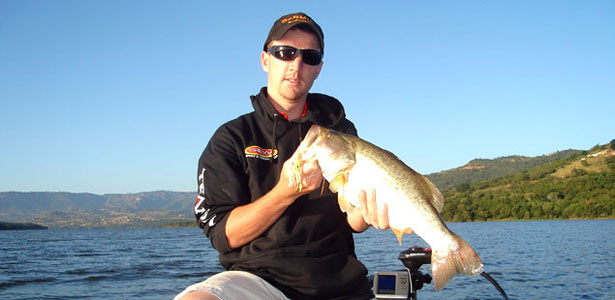
If you want to catch as many fish on spinnerbaits as the anglers around you, then fish it like they do –but if you want to put more and bigger fish in the boat, then slow-roll it!All this requires is a change in approach, an adjustment in technique and obviously the correct spinnerbait. While you can use your favourite spinnerbait for this unique style of fishing, I would suggest you follow some pertinent principals to maximize your results.
My affliction for slow rolled spinnerbaits has produced epic tournament result as well as some behemoth bass. Among the numerous slow rolled monsters I have landed is my personal best of 5,7kg at Albert Falls. A hot summer’s day with high sun had done exactly what it normally does, namely shut the bass down. The early morning bite had not lasted long and the mid morning funk had set in. A slow rolled spinnerbait under these though conditions will often change your day. I was fishing with Eric Gander and we were slow rolling submerged timber off the main island of Center Trees. My 3/8oz Fire Tiger Stanley Spinnerbait with a customised Colorado and Indiana blade combination was methodically ticking the submerged timber. Each time it made contact with the timber, I would pause it for a second to let it flutter momentarily before setting the blades back in motion.
When it came the hit was unmistakable - the rod loaded up and the slip of the drag when I set the hook confirmed the magnitude of the fish. The fish reacted immediately and surged hard, taking refuge in the closest piece of timber. This was make or break – “give it slack and it may swim out, or deeper in, maintain pressure and get her out, but maybe break off”. I maintained pressure and kept the rod tip high and then “Basszilla” turned and headed towards the surface. She broke the surface aggressively but was disadvantaged due to her size with her head and gills barely clearing the water. I was able to turn her head and take control, and after a few intense but lackluster surges I had her beat and she was soon in the boat. The rest of the day meant nothing - I had made personal history!
 Choosing a Slow Roller
Choosing a Slow Roller
As the name suggests, slow rolling is the slower, deeper approach to targeting bass with a spinnerbait. Sure, ripping a double willow leaf through visible vegetation and timber puts ‘em in the boat, but what about when these fish move offshore, or there is no visible cover? If fish are offshore or stacked up on submerged cover, then why use a spinnerbait to entice these fish when so many other baits may do this as effectively? Simple - how many fish in 10-30ft of water get to see a spinnerbait? This is a totally fresh and under utilised pattern on our waters simply because anglers do not have confidence in this technique. As mentioned before not just any spinnerbait will suffice - blade configuration is vital and a heavy compact spinnerbait is preferable.
There are 3 blade shapes that best suit slow rolling:
* Colorado - this is the most commonly used blade for slow rolling. A slightly larger than recommended main blade will slow your presentation even more, so upsize.
*Oklahoma - not the most widely used blade but very effective. The sharp taper on this blade emits a controlled yet aggressive vibration and deflects off timber with ease.
* Indiana - the perfect option for submerged vegetation. The elongated shape of this blade crawls through vegetation and still maintains vibration at low retrieve speeds.
Combine you main blade choice with a smaller front blade of the same shape but in a different colour. I normally opt for a gold or copper main blade and a silver front blade. This contrast is a productive choice for cleaner water. In dirtier water, I will use double gold or copper for maximum visibility.
The choice of weight will depend on the depth at which you are fishing. Always try and fish the heavier of the two you are trying to decide on. The heavier one makes bottom contact more precise and means less time waiting for the bait to reach the bottom! A heavier spinnerbait also helps to differentiate between structure and bottom composition.
Understanding the spot you are fishing in is vital. In water up to 15ft deep, a 3/8oz model is definitely suitable - deeper than this and I will switch to at least a 1/2oz or even a 3/4oz model.
So what colour? No colour replaces confidence, so use your favourite colours. But be prepared to change the skirt colour when you favourite choice isn’t working! I personally allow the depth I am targeting to depict the skirt colour. The deeper I am fishing, the darker the skirt will be - this is obviously the correct hue for dirtier water as well. Great colours for the deeper zones include Black /Blue; Junebug and Gold Shiner. For shallower water - unless it is muddy – the colours to choose include White/Chartreuse, Chartreuse, White/Silver and any other natural skirt representation. Pay attention to the predominant baitfish found in the shallow areas and duplicate where possible!
Trailer options vary. Choose a trailer that is practical – it adds buoyancy to your spinnerbait and allows you to slow down your retrieve rate, but don’t oversize your trailer as this will restrict casting distance and increase the profile of your bait. An increase in profile is sometimes the intention, but if not your intention then keep it simple. Lightning strips, twin tail grubs, curl tail grubs and ribbon tail worms are all the top performers. Contrast your skirt and trailer colours as this minor adjustment sometimes delivers major results. I will change my spinnerbait and trailer at least 3 times in a day until the fish respond to a specific presentation, then it’s go time. If you are missing bites, be sure to add a trailer hook to remedy short strikes!
I utilise slow rolling spinnerbaits manufactured by a few brands such as Picasso; Stanley and Booyah, but as long as your weight choice and blade configuration is correct, most brands will do the job!
The Technique
All your tackle and bait choices will result in nothing unless you understand the technique. Slow rolling requires maximum “bottom time”. Your spinnerbait will only be in the strike zone for a percentage of each cast. Understanding the technique will result in this percentage being as high as possible. Make long casts, as long as possible, and let the bait sink to the bottom. Pay attention though, as suspended fish will hit the bait on the drop!
Once the bait is on the bottom, a twitch of the rod tip will set the blades in motion and the vibration of the rod tip will confirm this. The spinnerbait is now moving and the blades, skirt and trailer bait are working together with enticing intent. Slow your retrieve as much as the blades allow, just enough to keep them turning. Pause intermittently to let the spinnerbait make bottom contact, keeping it in the strike zone for as long as possible. Your spinnerbait must crash into the timber, rocks and submerged vegetation - this is when they bite so get your bait there!
Similar to the concept of a crankbait, the slow rolled spinnerbait will pendulum on the sink and retrieve. With this in mind make sure you are close enough to the cover to ensure you fish it effectively, but stay as far away as possible. This is a fine line to position your boat on but practice this, as your bait needs to be at the correct depth when making contact with the submerged cover. When targeting drop-offs make sure your approach is parallel. It is extremely challenging to slow roll a spinnerbait when the depth is changing. A parallel approach will allow you to cover the bottom contour efficiently and also determine at what depth the fish are holding.
Submerged vegetation is a classic slow rolling pattern. Let your spinnerbait tick the vegetation and allow it to almost snag in the grass, and then rip it free to generate reaction strikes. Concentrate on the deeper weed edges and focus on the areas closest to the break line or drop-off. Covering the flats has never been easier - this is a killer technique for these summertime haunts and the slow roller will make short work of these areas. Fish the slow roller methodically, concentrate and visualise the bait’s movements. A slow rolled spinnerbait may not catch as many fish as alternative techniques, but will definitely appeal to the bigger fish in the lake, so fish it with determination as these fish win tournaments.
Tackle Choice
The technique of slow rolling requires a particular and precise choice of rod and reel. A 6’6” or 7’ medium action rod will do this job perfectly. The length will assist with long casts and the slow medium action of the rod will allow the fish to inhale the bait before you feel the strike. This means more hook-ups and fish landed. My personal choice for this is a 6’6” medium action Team Daiwa Spinnerbait/Crankin rod. A slower retrieve ratio reel will compliment your choice of rod. A 4.8:1 or 5.1:1 ratio will keep your spinnerbait running true and deep without causing it to rise too quickly in the water column. This is crucial! I spool up with 15lb “Big Game”. I wouldn’t fish lighter than 12lb and not heavier than 17lb. Your line brand of confidence should suffice.
The art of slow rolling will produce results all year round and draw strikes in any cover and depth available. Strategically cover the flats and off shore weed lines, parallel the drop-offs and penetrate submerged timber. The slow roller will catch pre-spawners, post spawners; active and inactive fish.
With so many options, the slow rolled spinnerbait will not only soon become the most versatile bait in your approach but also an approach that will be uncontested by most anglers. So get out on the lake and start rolling, namely slow rolling!
*KZN bass angler Grant Hewitt is a GOYA Pro Staff member.


 Visit us our
Visit us our